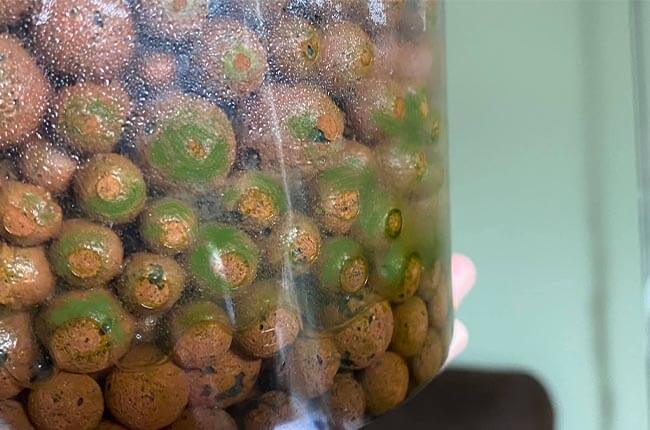Algae can become a problem when growing orchids and other houseplants in a semi-hydroponic setup with an inorganic medium such as LECA in clear pots. They are aesthetically unappealing to some people and they grow very quickly that can suffocate the roots of the plant.
To prevent algae from getting out of control in a semi-hydroponic setup, preventive measures can be adopted such as using opaque pots to block the light, regular flushing of reservoir, lowering the feeding of phosphorous and repotting every few years.
The management of algae in growing vegetables hydroponically is different from that in growing houseplants semi-hydroponically. The difference is that a deep clean and sterilization can be done to the hydro system after harvesting the veggies, while the houseplants are not frequently removed from the pot unless repotting is needed. The management of algae in semi-hydro thus presents the challenge of removing algae without affecting the health of the plant.
Let’s take a deeper look at how to do this.
1. Why is there algae in the semi-hydro setup?
Algae is a plant-like organism that grow in an aquatic environment. Like most plants, they require light, nutrients and water to conduct photosynthesis and multiply.
They are extremely versatile and can get into a system via microscopic airborne spores.
They can be carried into your semi-hydro pots by the wind or even by the growers themselves without realizing it.
Their existence is often an indication of over-fertilizing especially in phosphorous.
2. Is algae bad or tolerable for plants in semi-hydro?
Bad: Algae grows fast and dies fast. The decomposition of dead matter not only let out a stinky smell, it uses oxygen and releases carbon dioxide that acidifies the water. The drop in pH can cause nutrient lockout and thus affecting the growth of the plant in the semi-hydro system.
Also, the decomposing substances will build up in the medium that can suffocate houseplants and orchids with fine roots such as Oncidiums.
Since algae have the same needs for light, oxygen and nutrients as plants, they compete with the plant roots for nutrients.
But is algae tolerable for plants in a semi-hydro setup?
Tolerable: Algae mostly grows in the reservoir where there is water and mostly on the walls of the clear pot and rarely grows into the inner parts of LECA or the medium where light cannot reach. Algae often does not exist in the inside of the medium where the bulk of the roots are. So, the existence of algae does not really suffocate the roots and compete with the plant for oxygen.
The existence of algae is more of an aesthetic issue and does not hurt the plant in the semi-hydro setup.
3. How to remove algae without repotting?
If you really want to remove the algae buildup, it can be done effectively in-situ by applying chemicals, such as Physan 20 (1 teaspoon per gallon or 4 liters) or bleach (1 ounce per gallon or 30ml per 4 liters).

However, it must be noted that these chemicals will also kill the beneficial bacteria around the roots of the plant, which studies have found are crucial for plant growth such as fixing nitrogen and helping with roots formation in orchids (Tsavkelova et al., 2007). Removing the beneficial bacteria will thus stunt plant growth, making orchids go dormant for reportedly about six weeks.
The best approach to algae management is, therefore, to tolerate it rather than remove it, if it is not out of control.
4. Tips to avoid algae buildup and re-growth
There are several measures that you can take to prevent and reduce algae buildup:
1. Put the clear pot (better plastic) inside an outer pot that is dark or opaque so as to stop the light from reaching inside. Other creative ways include paint, black tape over the part where the reservoir is or wrapping a black sleeve on the outside of the pot.
2. To prevent an acidified medium due to decomposed algae, flush the pot with water thoroughly and regularly to remove decomposed substances and refresh the water in the reservoir.
3. Prevent over-fertilizing, especially fertilizers with a high content of phosphorous.
4. Finally, plants in semi-hydro should be repotted into a clean sterilized inorganic medium every few years or when there is too much algae. Otherwise, the algae bloom can suffocate plant roots and cause plant death.
Conclusion
To sum up, we should not try to aim towards that unrealistic goal of getting completely rid of algae in a semi-hydro setup.
Algae can be prevented by using opaque pots to block the light, regular flushing of the medium, prevent over-fertilizing and repotting every few years.
The best approach is to ignore the algae until it’s time to repot. In fact, the plants that are left alone with algae to grow in their semi-hydro setup are often the ones that grow the best.
Happy growing!
Sources
Tsavkelova, E. A., Cherdyntseva, T. A., Botina, S. G., Netrusov, A. I. (2007). Bacteria associated with orchid roots and microbial production of auxin. Microbiological Research, Volume 162, Issue 1, Pages 69-76.
- Top 6 Drip Irrigation Systems for Raised Beds (2025) - January 31, 2025
- Top 10 Orchid Fertilizers: A Comprehensive Review (2025) - January 16, 2025
- Top 6 Slow-Release Fertilizers for Houseplants & Veggies (2025) - January 15, 2025

